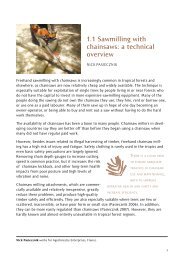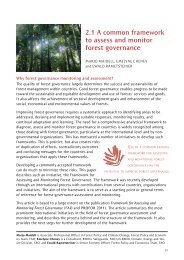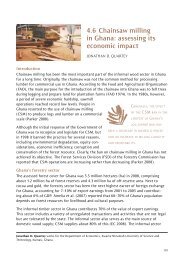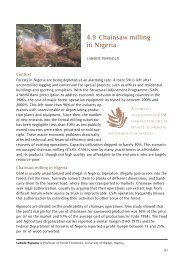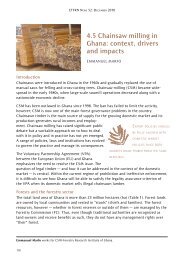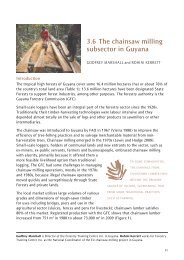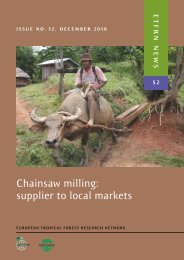Chainsaw milling: supplier to local markets - European Tropical ...
Chainsaw milling: supplier to local markets - European Tropical ...
Chainsaw milling: supplier to local markets - European Tropical ...
You also want an ePaper? Increase the reach of your titles
YUMPU automatically turns print PDFs into web optimized ePapers that Google loves.
3.3 susTaiNablE maNagEmENT oF guaDua bamboo FoREsT, colombia<br />
Guadua forests are highly fragmented and most patches are smaller than five ha<br />
(Camargo and Cardona 2005). however, these forests are an important refuge of bio-<br />
diversity where more than 400 woody species have been identified. They also provide<br />
habitat for about 50 birds species and 18 mammals (bats), which fulfill important<br />
ecological functions (CiEbrEG 2008).<br />
because of the nature of guadua culms, 1 logging and processing is usually conducted<br />
using a machete, although recently chainsaws have been used in some places. harvesting<br />
of guadua forest consists of the extraction of a fraction of<br />
mature culms. a significant number of standing culms with<br />
different stages of maturity remain in the forest if it is effectively<br />
managed (the density is on average 6,500 culms per<br />
ha). Further fragmentation of these forests has implications<br />
for silviculture, because larger areas of guadua stands would<br />
be required <strong>to</strong> meet demands. a number of farmers, wishing<br />
<strong>to</strong> avoid the costs of forest planning and technical assistance,<br />
are not managing the small guadua areas properly. although<br />
most of the culms harvested are used for domestic applications<br />
and harvesting intensity is usually low, the silvicultural<br />
practices <strong>to</strong> obtain them are unsustainable.<br />
unsustainable domestic harvesting sometimes causes environmental<br />
damage and increases the susceptibility of guadua stands <strong>to</strong> wind and rains<strong>to</strong>rms<br />
and <strong>to</strong> decreased productivity and quality. higher profits would be obtained if an effective<br />
technical process for harvesting were applied.<br />
Guadua is the most highly harvested species, and provides wood for a variety of uses.<br />
some reports show that between 2000 and 2004 roughly 2,420,000 culms of guadua were<br />
logged from 2,557 ha (moreno 2006a). This means that about 90% of guadua stands were<br />
not harvested during that time. Guadua bamboo forests have been significant in<br />
supplying and sustaining small and medium enterprises (held 2005) and have improved<br />
the likelihood of reaching <strong>European</strong> <strong>markets</strong> (becker 2004). unfortunately, data related<br />
<strong>to</strong> guadua harvesting have not been registered since 2004. according <strong>to</strong> the number of<br />
harvesting permissions requested and the number of guadua poles sold in timber s<strong>to</strong>res, it<br />
is apparent that commercial use continues <strong>to</strong> be high.<br />
when harvesting, a portion of mature and over-mature guadua culms are cut, then each is<br />
divided, usually in four pieces, according <strong>to</strong> intended use:<br />
• cepa is the base of the culm, approximately the first three metres (m) of height, and<br />
is mainly used for domestic purposes such as fencing;<br />
• basa is the next piece (about three <strong>to</strong> nine m of height), which has a higher<br />
commercial value and therefore is utilized for different purposes;<br />
• sobre basa is the next piece (about nine <strong>to</strong> 15 m of height), which is usually manually<br />
flattened for making mats or esterilla;<br />
73



